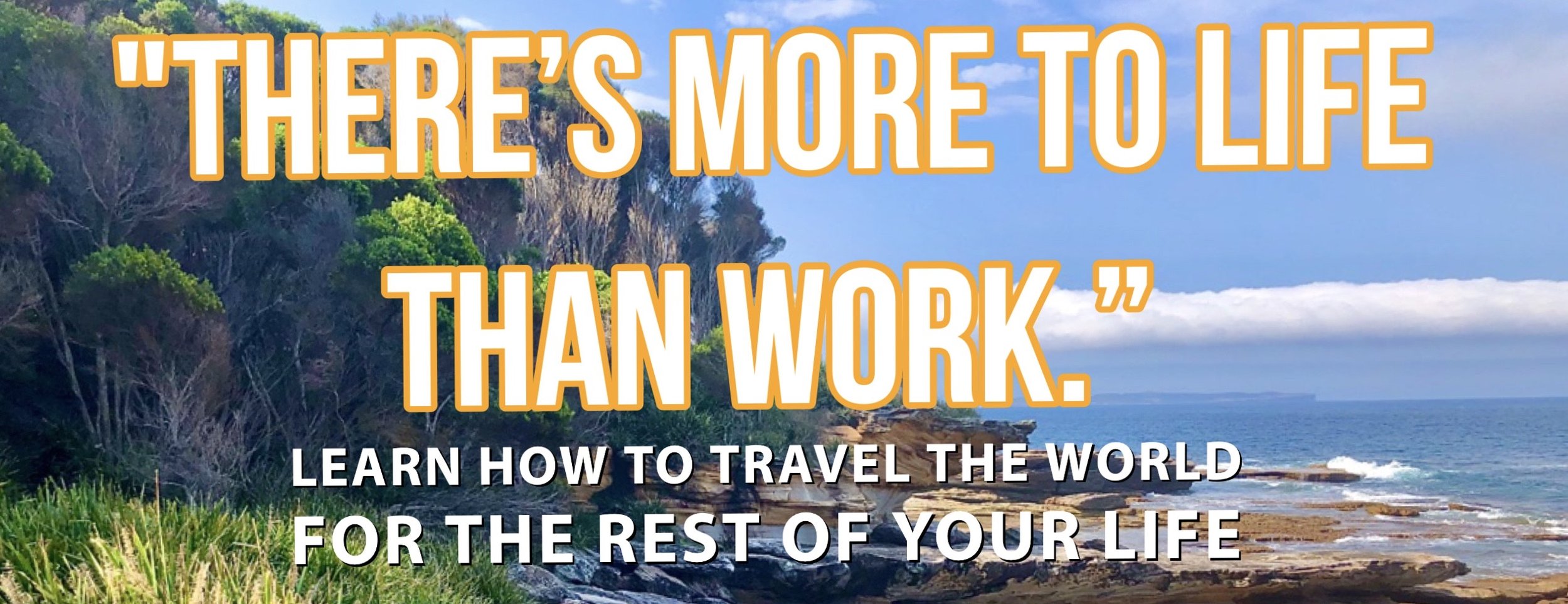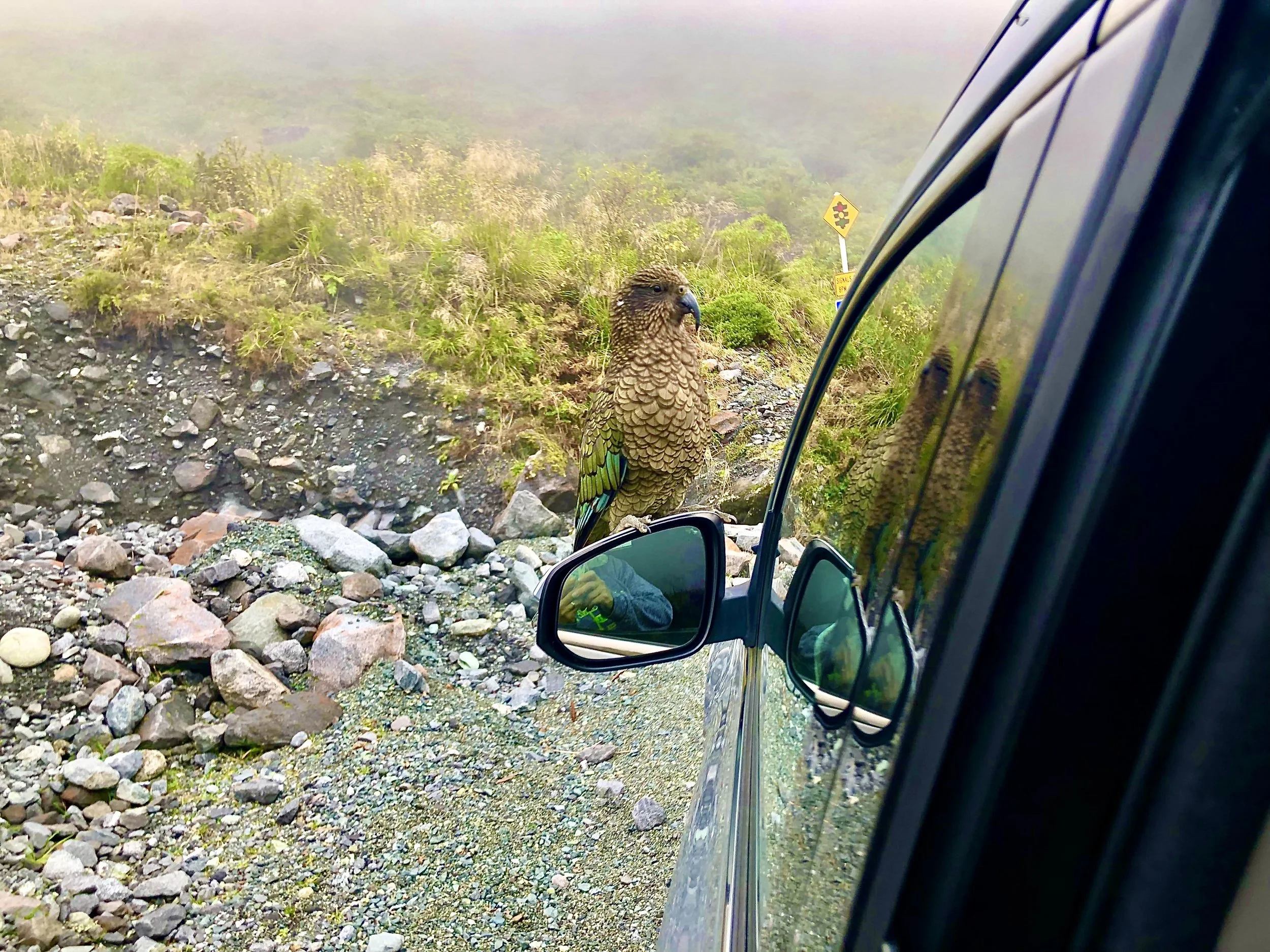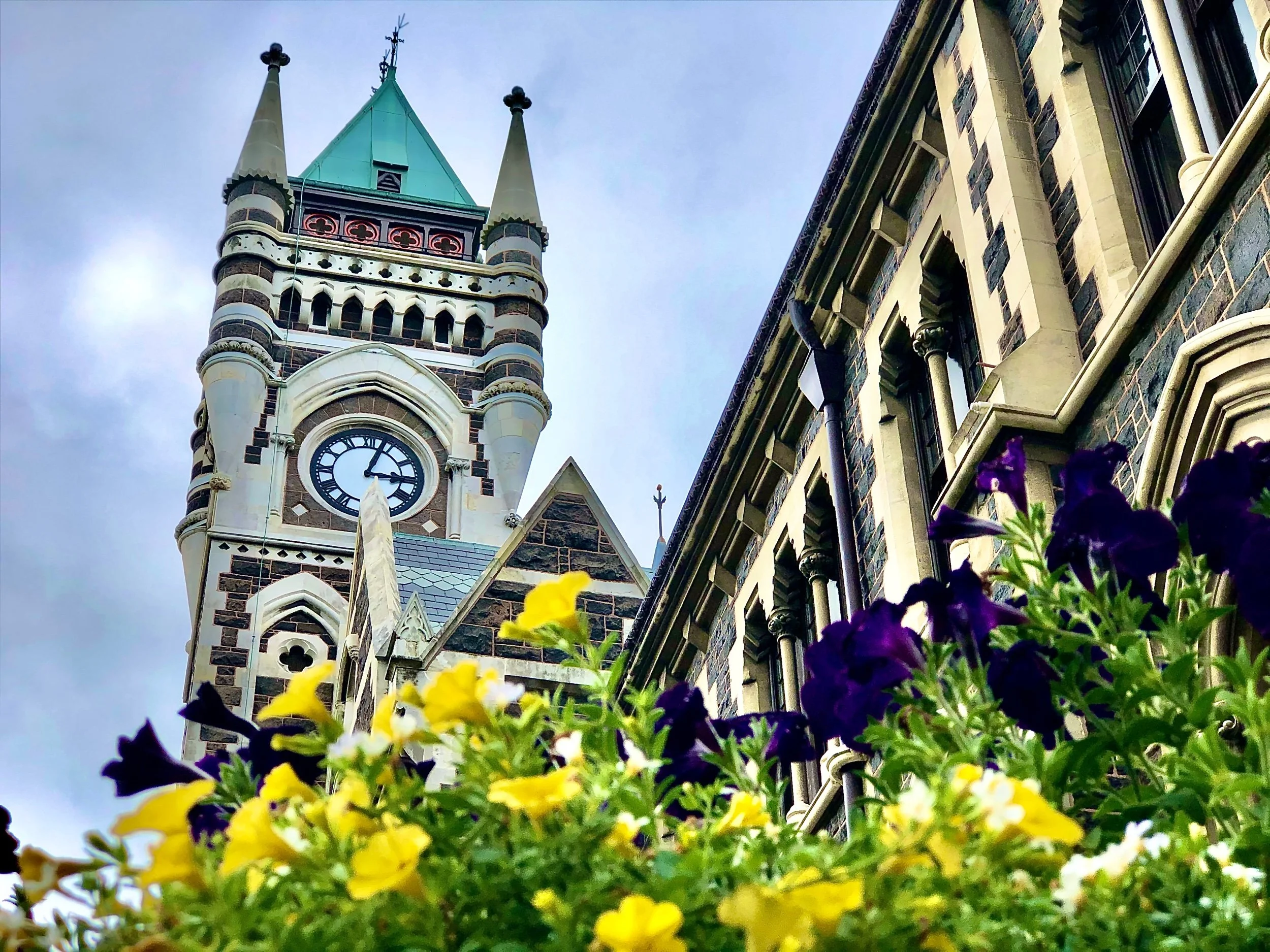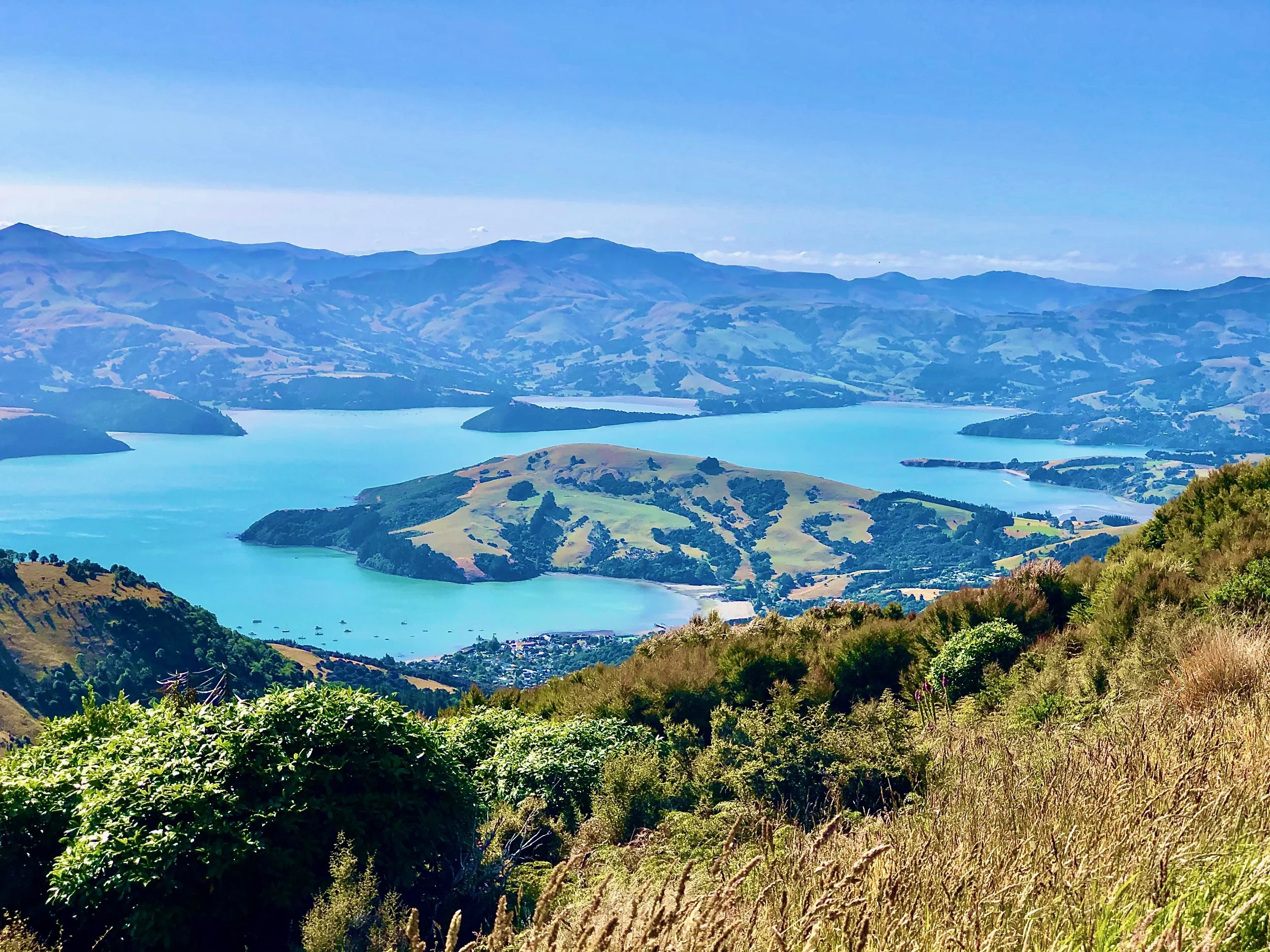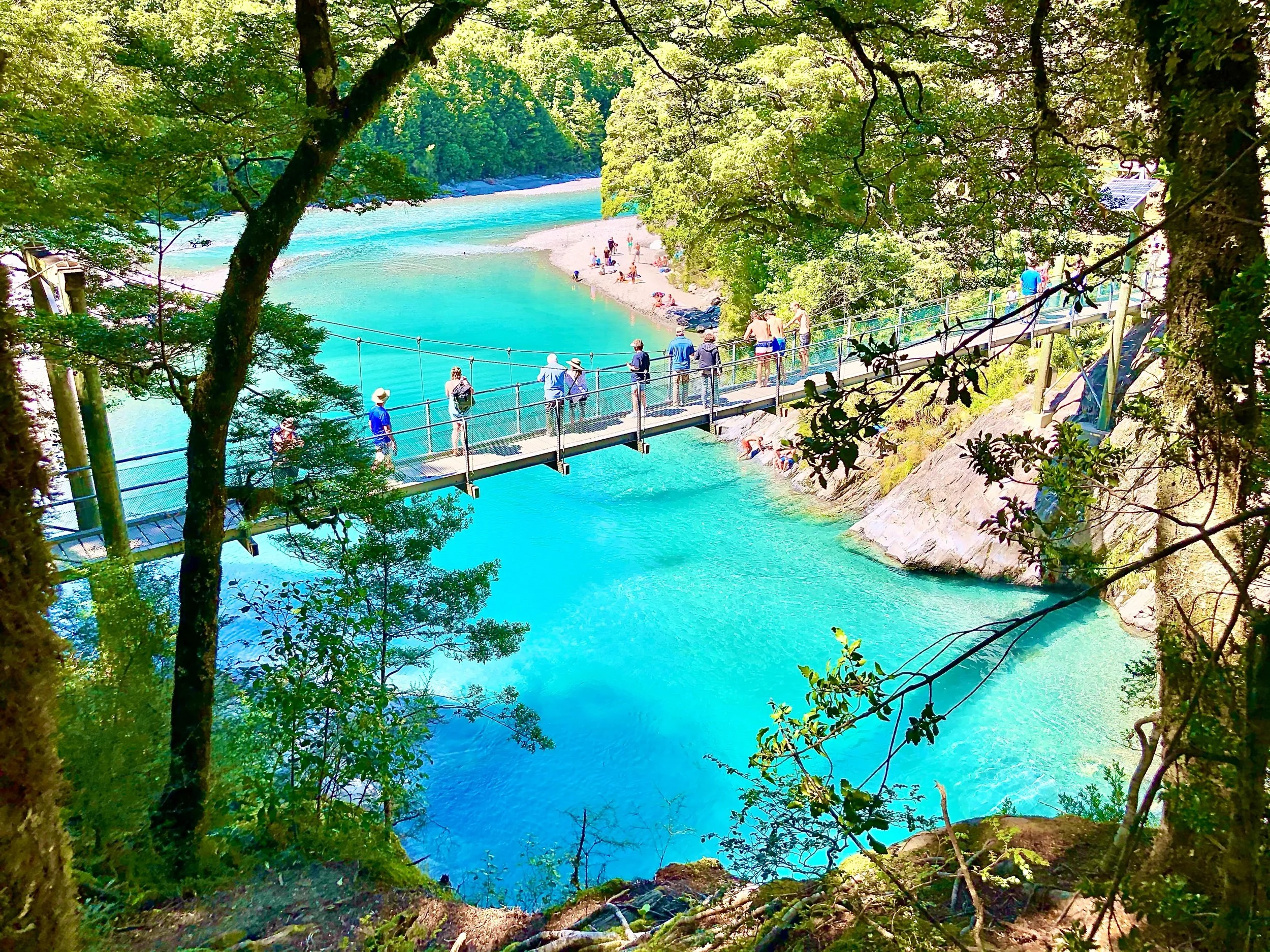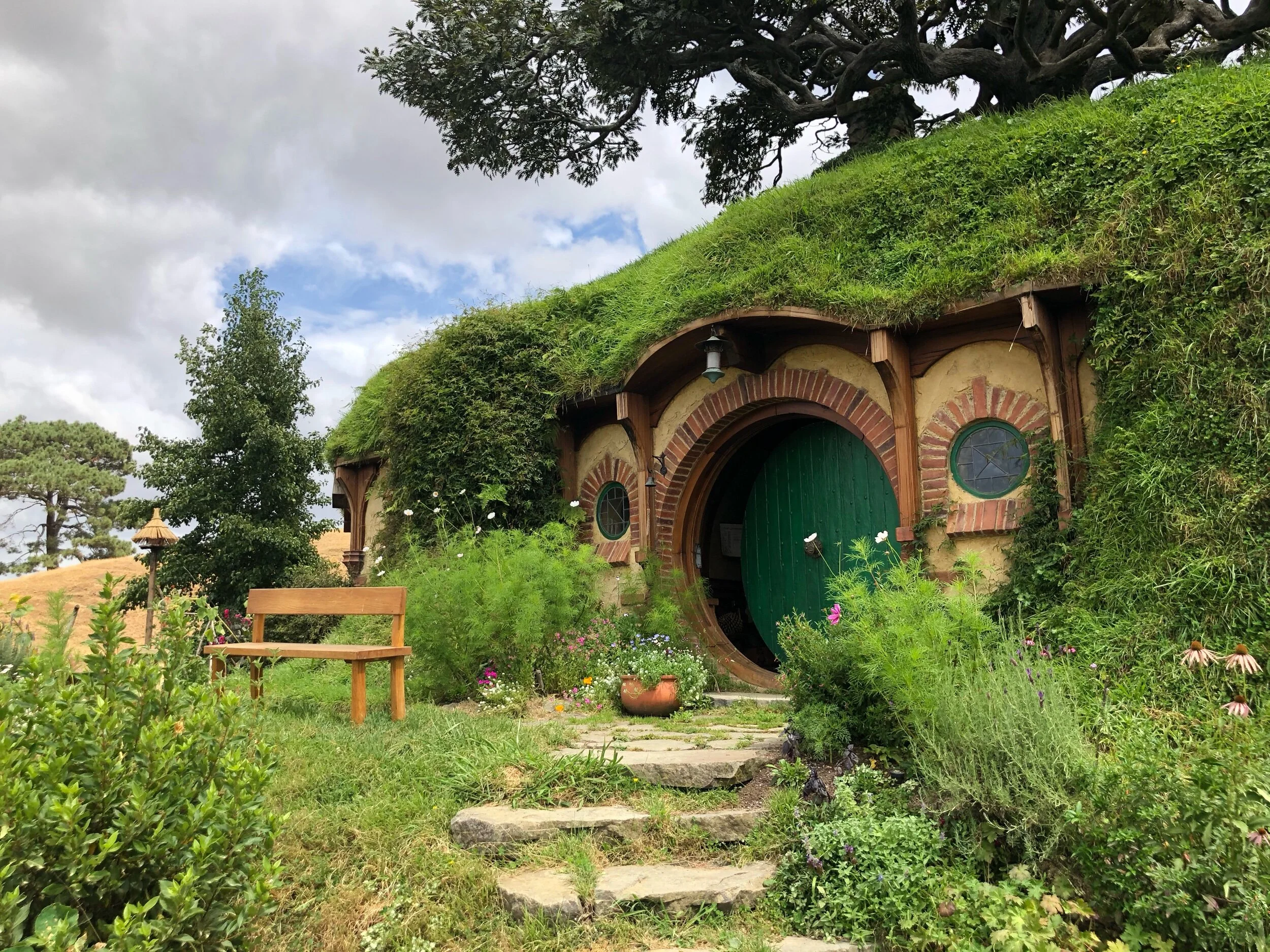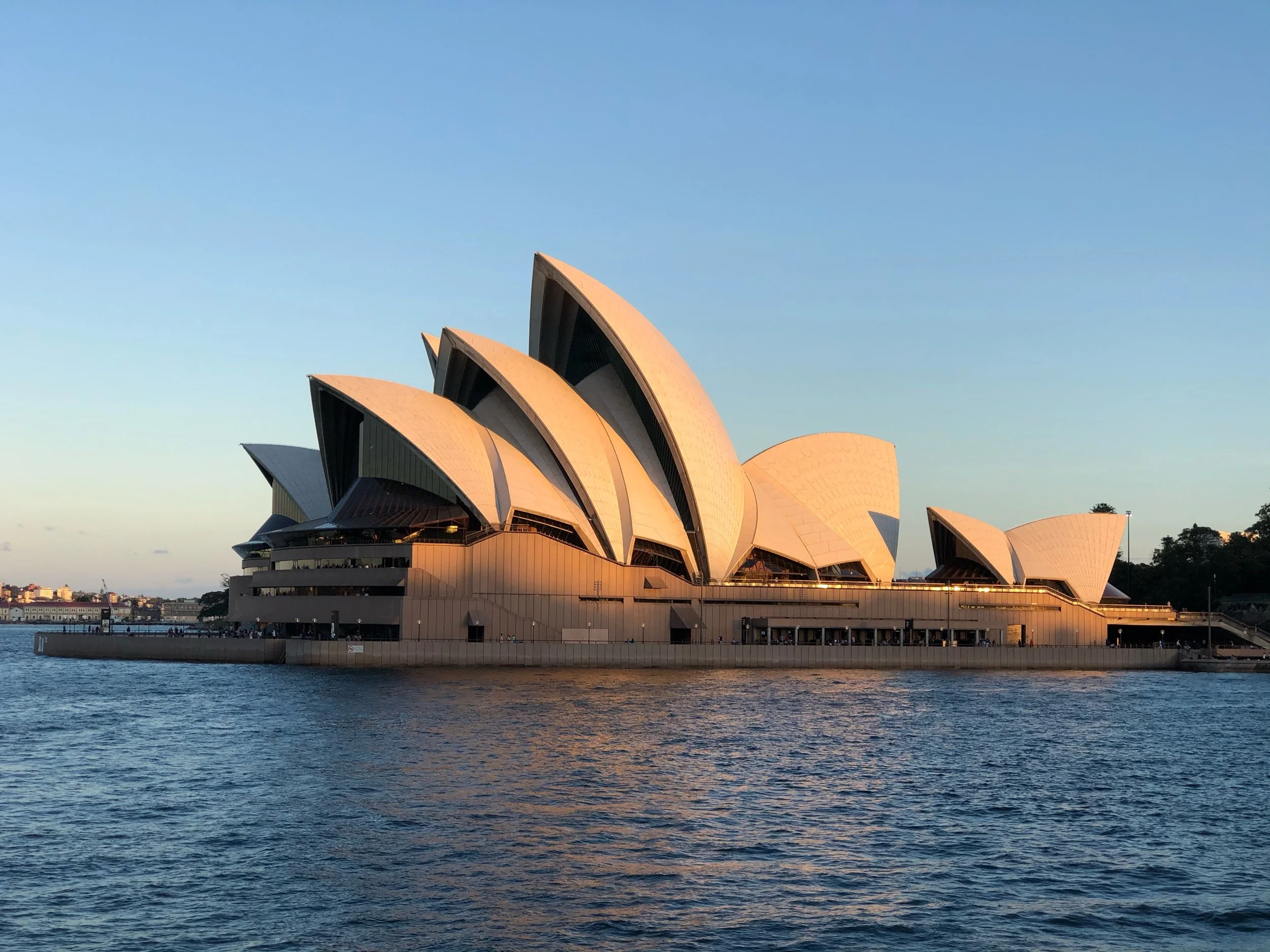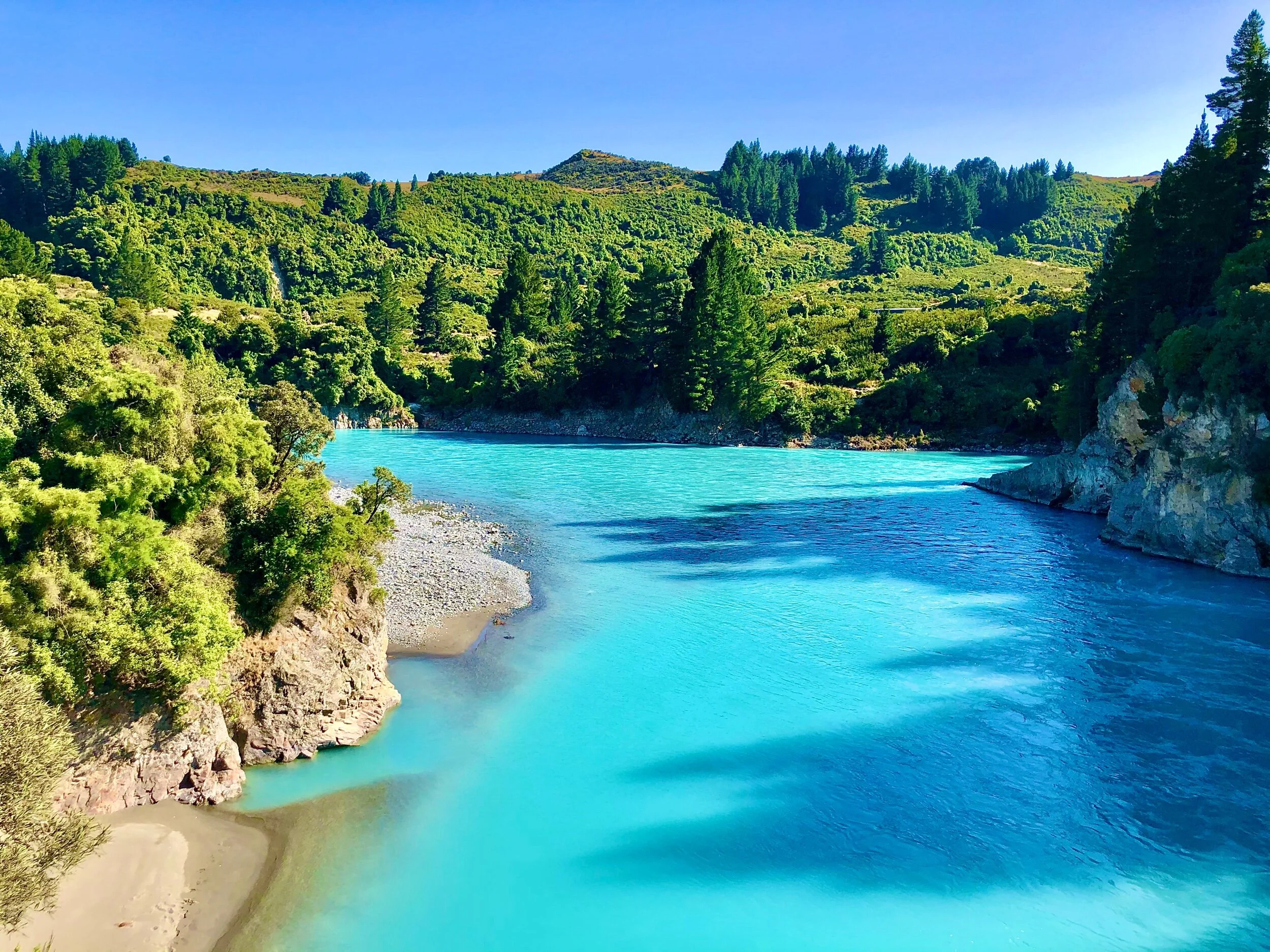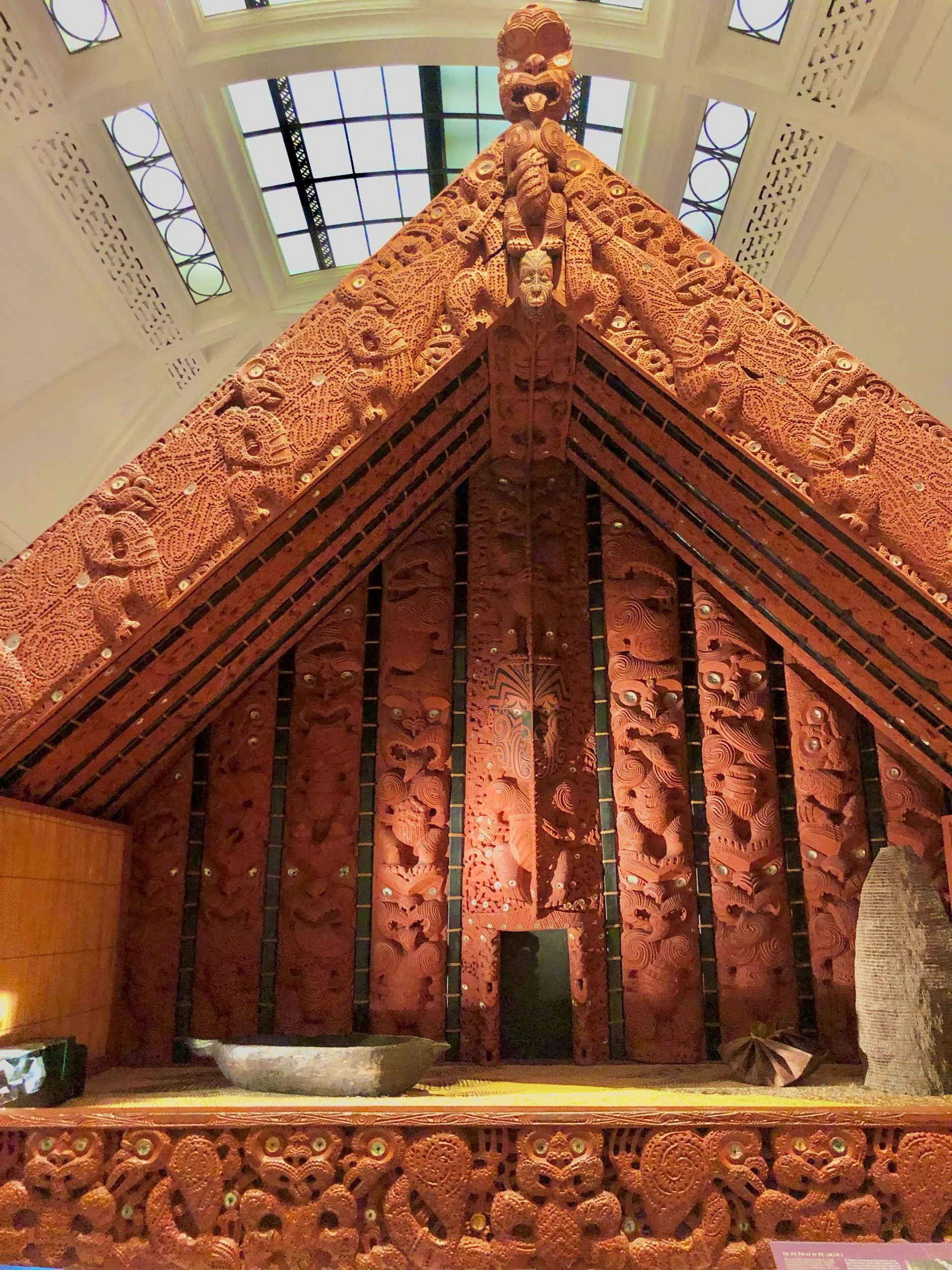Accredited Employer Work Visa to NZ Residency - Becoming Expats in New Zealand
Please note: This post may contain affiliate links. See our disclosure to learn more.
A view of Milford Sound looking out from the rainforest canopy with snowcapped mountains in the background from the Milford Sound Trek.
Our Travel Story > Accredited Employer Work Visa to NZ Residency - Becoming Expats in New Zealand
Starting Our Journey with the Accredited Employer Work Visa
Embarking on the journey to live and work in New Zealand as a foreign professional is an exciting but complex endeavor, often beginning with an Accredited Employer Work Visa (AEWV). This visa is a popular entry point for those wishing to join New Zealand's workforce, especially for families, like us, who see the country as a potential second home.
For us, it marked a major turning point in our “Barista FIRE” journey—a lifestyle that blends financial independence through investment income with remote work flexibility, allowing us to travel and live comfortably in diverse places around the world. This year, however, saw our transition from full-time travelers to New Zealand residents as we took the necessary steps toward an Accredited Employer Work Visa and ultimately, New Zealand residency. Here, we’ll walk you through the process, from job searching to visa applications and the unique challenges of building a life in New Zealand.
We’ve also provided a helpful FAQs section down at the bottom for those of you who are looking to work in, or migrate to, New Zealand as well!
Below is our emotional - and exciting - journey of getting an Accredited Employer Work Visa and Residency in New Zealand.
Why New Zealand? Choosing a Second Home
If you’ve been following along with our story, you’ll know why we decided to settle in New Zealand. As we traveled the world, we were drawn to places where we could see ourselves putting down roots. New Zealand stood out—not only for its stunning landscapes but also for its culture, emphasis on family, and quality of life. As parents, we saw potential in raising our children in an environment that values safety, education, and a connection to nature. We realized New Zealand was the ideal place to elevate our Barista FIRE lifestyle and make a longer-term commitment.
Our move to New Zealand also felt like a professional progression. Bradley had been developing his skills in data analysis and financial planning—skills honed through resources like the Remote Coding Bootcamp, which he used to advance his skills in data science and business intelligence tools. We were ready to settle into a place where he could apply these skills in a meaningful way, potentially contributing to New Zealand’s drive for renewable energy and sustainability.
KiwiAmericans is a great resource for everything you need to know before moving to New Zealand
First Steps Toward the Accredited Employer Work Visa
Securing an Accredited Employer Work Visa in New Zealand requires careful planning. We began by researching the visa requirements and working with an immigration advisor to guide us through the process. Our primary goal was to align Bradley’s skills with roles in New Zealand that could support our long-term residency goal.
Our immigration advisor guided us through document collection, background checks, and other AEWV requirements. Here are the main two steps necessary to get started, which an immigration advisor can help you with:
Choosing an Entry Visa
One of the first steps involved choosing the right entry visa. While it’s possible to attach residency to your application immediately by using the “Green List” Straight-to-Residency Visa (which is basically an essential skills work visa), the main paths that people use to get residency begin with either a Student Visa combined with the Post Study Work Visa (a.k.a. the Student Work Visa), or either a Working Holiday Visa or an Accredited Employer Work Visa followed up with a migrant visa. Other ways to gain access to New Zealand are through an investment or entrepreneur visa, but the timeframe and difficulty of getting those visas end up making them much less used. The AEWV, unlike visas for students or investors, is a structured pathway to residency, especially for skilled professionals with job offers from accredited employers.
Document Preparation for the AEWV
Gathering documents was another major task, requiring proof of identity, extensive relationship proof (to also get a Partner Visa and Dependent Child Visas), character certificates, educational qualifications, and verification of skills. We talked about this more in our Year 5 article, but this step requires collecting all of the required documentation. Fortunately, Bradley had a great shot at using his MBA specializing in finance, as well as his recent training in data science, as leverage for skilled work in New Zealand - strengthening his application by showcasing skills in high demand.
Looking Up Everything We Needed to Know about Moving to New Zealand
Moving to a new country comes with a whirlwind of questions, and for us, New Zealand was no exception. We dove into researching everything we could about settling in New Zealand, from the visa application process to understanding the lifestyle differences and family-friendly neighborhoods. We also wanted to know about essentials like healthcare, education, and the cost of living to ensure our move was both sustainable and enjoyable. Through hours of research, we found valuable resources like the Kiwiamericans website—a site dedicated to helping Americans understand what it’s like to live, work, and thrive in New Zealand. With personal insights from expats who had already made the journey, Kiwiamericans provided helpful guides on everything from Kiwi slang to driving rules and common workplace expectations, which helped us feel prepared and excited about the move.
Kiwiamericans has a wealth of information specifically tailored for Americans adjusting to New Zealand life. The site covers practicalities such as navigating New Zealand’s banking system, tax obligations, and grocery shopping, along with fun, culture-focused topics like Kiwi dining habits and popular New Zealand festivals. This blend of practical and cultural insights was invaluable for us as we prepared to become residents in a country so different from the U.S. Having Kiwiamericans as a resource gave us an insider’s perspective on what to expect, from making friends to learning the nuances of daily life in New Zealand, which made the move feel less daunting and more like an exciting adventure.
Jenny poses for a photo at Wairere Falls along the Kaimai Range not far outside of Matamata in New Zealand.
Navigating the Visa Application Process
After getting the documentation ready, applying for the Accredited Employer Work Visa was still a multi-step process. The Accredited Employer Work Visa (also known as the “AEWV”) requires that a work visa employer needs to become accredited to hire overseas workers. The accreditation process simply makes sure that the employers are treating their overseas workers fairly, and not taking advantage of them. Additionally, this visa requires employers to offer a minimum hourly wage to prospective migrant workers. When we entered, that was set as the New Zealand median wage of NZD $29.66 per hour. However, certain roles are exempt from this median wage requirement.
Job Search and Interviews
With our immigration advisor’s guidance, Bradley started an intensive job search. Finding an employer accredited by Immigration New Zealand was essential for the AEWV, but no specific list of accredited employers was available at that time. Instead, we relied on networking, job search sites like SEEK, and recruiters to find the right role. Plus, our advisors helped us by providing a letter to each New Zealand employer that let them know just how easy it is for them to get the visa employer accreditation, just in case they were interested.
Bradley’s background in data analysis, financial planning, and business intelligence became quite valuable during his job search. His prior roles in financial planning and data analysis made him a strong candidate for energy companies interested in these skills. In fact, there were quite a lot of roles being advertised that desired data analysis skills or basic programming skills! After a series of applications, Bradley received a call back from a recruiter at FIND Recruitment New Zealand, and they helped him set up interviews with a few potential employers.
Using the accredited employer work visa means that you also are required to have a job offer in hand in order to be approved, and it was quite difficult to convince employers to select a non-Kiwi (and non-Resident) to work for them. Although Bradley’s background was compelling, it still took considerable effort to convince employers to choose him over local candidates as the law prohibits taking an immigrant if a qualified local is also a candidate. However, with a letter from our immigration company stating that we had everything else for our visa already completed, employers could feel confident that our Accredited Employer Work Visa was going to be quickly approved.
Receiving the Job Offer and Initial Steps
Being in New Zealand for in-person interviews was a big advantage. Since we were present in the country on an NZeTA (visitor visa), Bradley was able to attend in-person interviews (“boots on the ground”), which proved to be immensely beneficial. His determination, coupled with the support of recruiters, was enough to get him a decent number of interviews. It's worth noting that recruiters in New Zealand are primarily intent on catering towards employers, and they will not hesitate to eliminate you as a candidate just as quickly as a hiring manager would if you disqualify yourself in something you say to them. The conversations aren’t confidential.
Employers eager to interview him sought the data analysis and excel modeling skills that he has, which are scarce in New Zealand. After approximately two months of diligent job searching and interviewing, he was requested by one of the companies to provide two referrals to fill out information on a site called Referoo. Once those were completed, he secured an unofficial job offer from a Wellington-based company!
Bradley’s unofficial job offer had a salary of over $130,000 plus a potential 10% bonus, in a role as a Senior Financial Analyst in the Financial Planning department of a major energy company. Getting jobs of this type, with salaries ranging from $90,000 to $140,000 are fairly typical in data science and analysis areas. This exciting offer marked a turning point for us, as it opened the door for us to finally apply for the AEWV. With our immigration advisor’s help, we prepared the final bits of the paperwork and began thinking about how our life was about to change as a family in New Zealand!
His role would focus on financial modeling, forecasting, and strategic planning—tasks that require strong analytical skills and proficiency in business intelligence tools. His goal was to help the company refine its financial strategies, supporting the company’s, and New Zealand’s, transition into clean energy (in this case, a solar energy project in the realm of 400MW). It was a perfect opportunity for Bradley to apply the skills he acquired through training, including the data science and analysis skills gained from the Remote Coding Bootcamp.
Hamilton Gardens near Matamata and not far from the Hobbiton Movie Set.
The Job Token and the Medical and Criminal Background Checks
One might expect that the job offer was the final thing we needed to get for the accredited employer work visa, but it wasn't. The job offer remains unofficial until after the employer submits a job check with New Zealand Immigration (INZ) and they approve it by giving out a job token, typically processing it within 10 working days. This is where Immigration New Zealand checks over the proof that you’ve provided them regarding your prior experience and skills to see if you’re a match for the job that you’ve been offered.
Immigration companies regularly tell people not to do Medical Checks, another requirement of the visas, until after receiving a job offer because they are expensive and only valid for up to 3 months. We checked and they were $1,766 NZD for all four of us (about $1,100 USD), so we decided that it would be best to wait for the “official” job offer first - because a declined job check would mean a large waste of money! That said, it did slow down the process a little bit.
So, we spent the next week exploring Matamata a bit more, including their Visitor Center - which looks like a Hobbit house - and took a few day trips out to the infamous L&P bottle, the Karangahake Gorge, and the Hamilton Gardens - all amazing places worth visiting! Moreover, it's worth noting that the Matamata area is virtually free of light pollution, allowing for exceptionally vivid and abundant stargazing on a clear night - which we absolutely loved showing the kids!
The checks were one of the final hurdles in our application, ensuring that we met New Zealand’s health and character standards.
A video of the damage done to the Hawke’s Bay area of Napier from the Cyclone in February of 2023.
A week after receiving the unofficial job offer, we headed down to Waitārere Beach, with a stop at the Napier Botanical Gardens, to relax a bit and get the final things prepared for submitting our New Zealand Visa paperwork.
Napier, however, offered a stark reminder of climate change’s impact on the planet (a warmer planet means that the atmosphere is capable of holding much more moisture, which in turn means more flooding).
Napier had recently been absolutely devastated by a flood, due to global warming, and we happened to drive along one of the main roads in that area on our way through - the farms and small villages over a distance of a few miles looked like they had been run over by a raging river with farms torn apart as well as houses and vehicles rolled over and shattered. It was quite an eye-opening sight! This type of event seemed to become more and more common across the world over 2024.
This eye-opening moment reinforced why New Zealand, with its focus on sustainability, felt like the right place to build a future.
Once in Waitārere Beach, a small beach town on the western coast about an hour and a half north of Wellington, Bradley had to do a criminal record check and a bankruptcy check for his job offer to be approved. Both fairly easy to submit for, and the records cleared within a few days without any issues.
Our immigration advisor then told us to book appointments for our health checks, even if we ended up needing to switch the days. We scheduled that for April 20th all the way up in Palmerston North, which was exactly 10 business days after the employer sent in the job check, coincidentally also the earliest we could find anywhere near our area. It seems most places in Wellington were booked solid for weeks! If you’re going through this process, we would recommend booking an appointment as soon as you receive an unofficial job offer as you can cancel if necessary.
A view of Wellington Harbour from the Lowry Bay area of Eastbourne, New Zealand.
Transitioning to Life in New Zealand
Finding a Place to Live in Wellington
After completing our AEWV application, we shifted our focus to finding a home.
On April 16th we visited Foxton, a small village with an authentic wooden Dutch windmill not far from Waitārere, to check it out and tour the windmill. Although the ladder was a bit steep, we all enjoyed this attraction and the Dutch items in the windmill store. The kids had a lot of fun climbing up the ladders, even if we were a bit anxious of them doing that!
A few days later our Airbnb host called us asking if we'd like to rent one of their friends’ houses for 6 months, which came as a bit of a surprise. However, we had to turn it down as we now needed a place for at least a year! Anyway, it got us thinking that we should probably be looking for a more permanent place to live for once!
The job check cleared on April 18th and our immigration advisor received a job token, meaning that the job offer matched Bradley's experience. He now had an Official Job Offer, and we could finally apply for our New Zealand visas. So, we signed those documents, and our advisor prepared our application, pending only the medical checks.
The Medical Checks
A relaxing few more days walking around down by the water in Waiārere beach, the adults on a strict health-food diet while the kids were having $2 ice creams at the 4-Square store and playing on the playground. The health-food diet was mostly for the exam, but we do like to eat healthy either way. When we went in for the exam it consisted of a physical medical exam and a number of medical questions for all four of us. Then a blood test for the adults. This whole process took about 2 hours and was really the last requirement for the accredited employer work visa, so it was a relief to have that out of the way. We sent the health check numbers to our immigration advisor so that she could affix them to our AEWV applications and Immigration New Zealand would see them once they processed.
Making Wellington Our Home
After getting a work visa, the next step is to get New Zealand Residency (if you desire - which was our primary goal to begin with). That requires basically moving into New Zealand and becoming a part of the society. So, once you have an entry visa, like the AEWV, the main things you'll now be able to get are a residential contract (rental agreement), a bank account, a driver’s license, and an IRD (tax) number.
So, as we were already in New Zealand on NZeTA visitor visas, we decided to open a bank account at the Bank of New Zealand (BNZ) so that we could officially sign a rental agreement (requires a local bank account number) and get paid in New Zealand dollars. There’s a little nuance about applying to the bank account “from overseas,” and with an international address, that allows you the ability to proceed this way, however. Otherwise, it’s a bit of a catch 22 on what you’re able to get done unfortunately.
Accredited Employer Work Visa Submitted
The very next day our advisor submitted our accredited employer work visa applications, although an “issue with the payment system at Immigration New Zealand (INZ)” ended up meaning that Bradley's visa did not get paid at that time, even though the other three did get paid.
A few days later, when the results of our medical exams arrived, they were added to our visa applications - so, in New Zealand, keep in mind that not all paperwork needs to be added on the date of the application - some can be added afterwards. Either way, we now felt that we could finally relax a little.
Searching for a House
As we waited on the results of the visa, we decided to start looking for a place to live in Wellington and to do what we do best - go explore! As competition for rental properties was quite high, we decided to use an introduction letter to get the best chance of approval.
While not required, introduction letters can help renters stand out by highlighting their background and reliability, making a positive impression in competitive rental markets.
We checked out places in Wainuiomata, Churton Park, Johnsonville, Khandallah, Ngaio, Hataitai, Island Bay, Karori, Days Bay, Eastbourne, and many others in Lower Hutt. Ultimately, we decided that the Wellington area has a lot of hills with tightly packed roads - including cars parked along them. We didn't enjoy driving in those cramped city conditions. The few spots that weren't like that were Days Bay and Eastbourne, which actually reminded us of Hawaii a little bit, so we focused our attention in that area and checked out an amazing place in Days Bay, overlooking Wellington Harbour, on April 24th even though the rent was quite a bit more expensive than we were hoping to spend.
Across Wellington Harbour from Days Bay was Wellington’s Central Business District (CBD), where Bradley was due to work. Luckily, there was also a short ferry across the harbour that dropped off only a 5-minute walk from his office. It could be an ideal place to stay, but we wanted to take a few days to consider the cost of the place and the reliability of the ferry.
ANZAC Day in Levin, New Zealand 2023.
Adapting to New Zealand’s Culture and Celebrations
Our new life in New Zealand introduced us to rich cultural experiences, like ANZAC Day, which honors soldiers’ contributions in WWI. We also visited Zealandia, an urban wildlife sanctuary dedicated to restoring New Zealand’s native ecosystem. These experiences deepened our appreciation for New Zealand’s cultural heritage and conservation efforts, reminding us of the incredible privilege of calling this country home.
ANZAC Day
April 25th was ANZAC day, an important national holiday in New Zealand similar to the American holidays of Memorial Day and Veterans Day. We visited Levin Memorial Park to watch the parade and listen to the ceremony. It is quite an event that commemorates and honors the part that the soldiers of the Australia and New Zealand Army Corps (ANZAC) played in the WWI battle of Gallipoli, which ended tragically for many Kiwis. For New Zealanders, it symbolizes courage, camaraderie, and the deep bonds shared with Australia, as well as the enduring respect for the nation's commitment to peace and freedom. The day is marked with dawn services, ceremonies, and a sense of national unity and reflection.
We saw these takahē, the largest living member of the rail family and the biggest flightless bird to survive in New Zealand, at Zealandia Ecosanctuary. Takahē are found only in Aotearoa New Zealand.
Zealandia Ecosanctuary
During his interview process, Bradley stayed at an Airbnb in Wellington for a few nights. The Airbnb host at that time offered to give us all a tour around a place called Zealandia. So, we decided to accept that offer and spent the next day being led by that Airbnb host through Zealandia Ecosanctuary.
Zealandia is a community-driven, 225-hectare urban wildlife sanctuary in Wellington, New Zealand, that protects and restores over 40 rare native species within a fenced valley and educates visitors about its 500-year vision for nature conservation and bringing the land back to how it was before even the native Māori people landed in New Zealand (before people).
The kids enjoyed walking through the nature area and meeting the native alpine parrots, called “Keas” (key-ah), and a few Weta (a local insect similar to a large cricket). Sadly, despite Toshi really wanting to see them, we missed the Tuataras (“dinosaur lizards” as our son loves to call them) because the weather was too cold. What a cool place to see!
Dutch Day celebration in Foxton at the windmill.
Applying for a Residential Contract
House-hunting led us through Wellington’s neighborhoods, ultimately landing us in Days Bay, a scenic area overlooking Wellington Harbour. Despite being more than we’d budgeted, the location’s beauty made it an ideal place to set down roots.
After a bit of contemplation, we decided to apply to the property that we looked at there. On April 26th we formally requested an application from the rental company and had all the paperwork signed, and the deposit completed, only 2 days later on April 28th.
Things seemed to be coming along quite well!
The next day there was a “Dutch Day” going on in Foxton, so we decided to visit it again. This time there was quite a bit more to enjoy, including traditional music, authentic Dutch food, and Dutch games. It was much more fun on Dutch Day and we'd definitely recommend it if you happen to be passing through at that time of the year!
Waterfall mountains along the drive into Milford Sound. Simply amazing to see so many waterfalls pouring down the sides of all of the mountains!
Residential Mishaps
During the Dutch Day event in Foxton, Bradley received a phone call from our Airbnb host’s friend. They had now decided to offer their home to us for a full year, and at the price we were initially looking to pay. It made our situation more complex yet again, but we agreed to at least take a look even though we had already signed a contract for a different place.
When we arrived, the walk to the house from the parking spot could be considered a small trail with about 30 stairs and a Z-shaped zig-zag up the side of a hill and through a very gorgeous little forest with fruit and flowering trees. It had accented wood beam ceilings and a massive deck in the front. The view overlooking Wellington Harbour was at least 3-times more gorgeous than the view at the place in Days Bay. And the living area was of decent size, although it was only a 2 bedroom, 1 bathroom place instead of a 4 bedroom, 3 ½ bathroom place. Expecting that we actually weren’t going to have many visitors in our first year, we looked at each other with the same gaze and Bradley said, “this could actually work.” It was agreed.
We went back at night to see how the area was in the evening, just to be sure. It was quiet, the lights from the city across the harbour were gorgeous, and there were hundreds of stars visible in the sky. We could see some lights from the homes located up the mountainside nearby from one of the bedroom windows, and it reminded us of a fairy village. At a weekly price 36 percent less than the one we already signed on, we decided to give up our deposit on the place in Days Bay and sign on this one instead. A lot of money saved in the long run, even though a bit lost upfront.
Update on Visa Status from Our Immigration Advisor
After sorting out the details of those contracts we headed to our final Airbnb before moving into our new place. A couple of days later, on May 9th, Bradley's new workplace reached out to our immigration advisor directly to ask about the status of Bradley’s accredited employer work visa - they advised the workplace that the visas were “under assessment” and shouldn’t take too much longer. Bradley believed that they were beginning to worry and might back out of the offer, so we called the immigration advisors the next day, seeing as our NZeTA visitor visas were also due to expire on May 13th, and informed them again that we still had not been charged for Bradley’s application fee yet. She sent an update to Bradley’s employer, with us copied in, on the 11th:
I’ve heard back from INZ today and the system glitched on submitting Bradley’s application. To correct the issue they have had to push the job token back to you so I can put another application in. Would you be able to email it through to me again and I’ll get this done today. INZ is waiting for the application so it can be given priority processing.”
On May 12th, a day before we were set to move into our new place and the day before our NZeTA visitor visas expired, we received another update:
“Hi Bradley, Everything is under control. [Bradley’s employer] actioned her part already so I can take care of the rest today.”
Something we learned about later was that the INZ system didn’t “glitch” upon the submission of Bradley’s application. Apparently, our immigration advisor had accidentally submitted Bradley's AEWV application saying that we were outside of New Zealand at the time that the application was submitted instead of stating that we were inside New Zealand (there's a tax to be applied if already inside the country). So, they had to remove that application and correctly resubmit it “today” - which was cutting it fairly close.
Fair enough. Maybe things in New Zealand are more casual, but it did feel like we lost 2-3 weeks of processing time due to this error. So, as our Airbnb also had a sauna, we decided to take turns enjoying that and getting in a bit more relaxation.
Residential Issues
Our move in date didn't go as planned either. Sadly, there was an overwhelming woodsy smell permeating through the house when we arrived, so we ended up contacting the owner, buying dehumidifiers and air purifiers, and sleeping another night at the Airbnb. It is a house build in 1930, so we weren’t sure about other things as well. We were suddenly concerned about mold or rotting wood, even though we didn’t see any at all. Not a great experience to have to deal with right at move in, and a tiring next few days trying to decide what we would do.
Luckily, we got it worked out enough that we were ok with staying overnight there during that time. A moisture barrier was installed in the underfloor not long afterwards, and a regular dose of using the dehumidifiers during free energy hours nightly, made the problem disappear.
Whaea June Te Raumange Jackson mural at Queens Wharf in Wellington harbour, honoring the late Maori leader and community advocate.
Typical Work Conditions and Benefits in New Zealand
Bradley was excited to start work as a Senior Financial Analyst in New Zealand’s energy sector, especially because his employment agreement included all of the typical benefits that come along with working in this country. New Zealand workplaces often have a supportive environment, with a good work-life balance and unique benefits such as these:
Annual Leave: Most companies offer at least four weeks of paid vacation each year, providing ample time for family trips or exploring the country.
Sick Days and Wellness: Employees typically receive 10 paid sick days and additional wellness days for mental health or family care.
Volunteer Days: Many companies encourage community involvement with at least one volunteer day a year, letting employees contribute to local causes.
Flexible Working: New Zealand workplaces often allow flexible hours or remote work options, making it easier for families to maintain a balance.
Learning and Development: Employees are encouraged to pursue skill development.
These were all part of Bradley’s work contract and made him excited to transition into the New Zealand work culture, providing a sense of stability and work-life balance for our family while supporting his professional growth.
Waterfalls run down the fern-covered Fjord cliffsides in Doubtful Sound, New Zealand.
Achieving New Zealand Residency
After officially receiving an AEWV, the next step was applying for New Zealand residency. This began with an Expression of Interest (EOI), which allowed us to enter a pool of candidates for potential selection. While we considered waiting, as our AEWV was still processing at the time, we ultimately decided to submit the EOI right away, hoping to fast-track our path to permanent residency (residency typically only allows you to stay in New Zealand indefinitely if you don’t leave after the first two years, whereas permanent residency allows you to travel to or from New Zealand indefinitely forever).
Submitting the Expression of Interest (EOI)
An "Expression of Interest" (EOI) in the context of New Zealand's residency process is an online form that potential immigrants fill out to indicate their desire to live in New Zealand. After getting a work visa and setting yourself up in New Zealand, it’s the next step in the process. Additionally, it’s the initial step towards applying for residency under schemes like the Skilled Migrant Category Resident Visa.
Our immigration advisor’s company sent out an email letting us, and anyone who was already eligible for New Zealand Residency, know that we would need to send in an EOI by May 17th if we wanted to be eligible for this round of migrant approvals. It's important to note that the EOI must be submitted by the cutoff day, which is generally in the month before the selection process. After a bit of deliberation on whether we should submit for this round or wait until a later date, we both decided that if we were eligible, we might as well do it now - just in case things changed later and to start the clock as soon as possible on getting Permanent Residency.
For the EOI, applicants must detail how they meet the visa requirements and demonstrate that they can claim enough points for qualifications, skills, work experience, and other criteria. The EOI fee (in 2023) for New Zealand's Skilled Migrant Category was NZD $590 for online applications and NZD $710 for paper applications. This fee was for Stage 1 of the resident application process.
After that, the EOI stays in a “pool” of candidates for up to 6 months (each time they let in a batch of immigrants, they select the most qualified based on New Zealand’s criteria and needs). If selected, the applicant is invited to formally apply for residency. The second stage, the formal “residency application” fee is considerably more detailed and runs NZD $4,890 for offshore applications and NZD $4,290 for onshore applications (2023). As we were already in New Zealand at the time, ours was the cheaper of the two.
The entire process, from EOI submission to invitation, generally takes around 2-4 weeks depending on the cut-off date for submission and allowing 2 weeks for INZ to check the selection pool after the selection date.
Stirling Falls, one of the most iconic waterfalls in Milford Sound, New Zealand, plunges 151 meters from towering green cliffs covered in dense foliage into the deep blue waters below. Located in Fiordland National Park, this stunning waterfall is a must-see for visitors exploring the natural beauty of New Zealand’s South Island, offering breathtaking views and an unforgettable experience amid lush rainforests and dramatic landscapes.
Different Pathways to Residency in New Zealand
The top visa types that people often use to obtain residency in New Zealand include:
The first three of these New Zealand Residence visas apply to people aged 55 or younger only.
Work to Residence Visa: This allows you to work in New Zealand and after two years, apply for a resident visa.
Skilled Migrant Category Resident Visa: This allows people with qualifications and skills that are needed for New Zealand's economic growth to work in New Zealand, and apply for residency sometimes even before two years, depending on your skills, qualifications, and pay level (which is used as a proxy for highly skilled vs skilled migrants). Also known as the Skilled Migrant Visa.
“Green List” Straight to Residence Visa: This allows people with a job offer from an accredited employer in a role on Tier 1 of the Green List to live, work, and study in New Zealand indefinitely. After two years on this visa, holders may be eligible to apply for Permanent Residence.
The next two options are also available for people aged 56 or older.
Entrepreneur Resident Visa: This visa requires that you first have an Entrepreneur Work Visa established, which is open to people 65 and younger. While we are not sure if it’s open to people 66+, it currently doesn’t seem to have a hard restriction.
Parent Resident Visa: This option is available to parents of New Zealand citizens or residents. To be eligible, parents need to meet health, character, and financial requirements, and the sponsoring child must meet an income threshold to support the application. This visa has limited annual quotas and can involve long waiting periods.
The next two options are open to those who are 66+ years old.
Temporary Retirement Visa: This allows people 66 and over to live in New Zealand for up to 2 years. It requires that you have NZD $750,000 to invest in New Zealand for a minimum of 2 years, an additional NZD $500,000 to live on, and an annual income of NZD $60,000 or more. *NOTE: THIS OPTION IS NOT A PATHWAY TO RESIDENCY. We are mentioning it because it may suffice for many.
Active Investor Plus Visa: Anyone can apply for this visa to live, work and invest in New Zealand. You must have at least NZD $15 million or the weighted equivalent in available assets or funds. Additionally, you can apply for permanent residence after 4 years of keeping your funds in New Zealand.
Generally, after two years of being a New Zealand Resident, you can either apply for “Permanant Residency,” which gives you the ability to travel outside of New Zealand indefinitely, or you'll have to stay inside New Zealand to retain your standard residency. If you travel outside of New Zealand after two years with standard residency, you will lose the residency visa and need to start all over again. Note that the Active Investor Plus Visa requires 4-years of invested funds in New Zealand prior to being able to apply for permanent residence.
A curious Kea parrot, known for its playful and inquisitive behavior, perches on the side mirror of our parked car near the Homer Tunnel in Milford Sound, New Zealand. As the world’s only alpine parrot, the Kea is native to New Zealand’s South Island and is a popular sight for travelers exploring the scenic routes of Fiordland National Park. This unique encounter highlights the Kea’s bold personality and the remarkable wildlife experiences available in Milford Sound.
Challenges and Delays in the Visa Process
Despite our best efforts, visa processing wasn’t without its issues.
Unforeseen Issues with Immigration New Zealand
With the EOI submitted and the house suitable enough to sleep in, we wanted to check in on Bradley’s accredited employer work visa to make sure that it was progressing as planned, and so that Bradley could get a decent update for his employer - apart from “it's processing” - so he decided to call up INZ directly to find out what was going on.
“You are unlawful,” they said. And that means that Bradley didn't have any active visas currently in the system. He was “an illegal” person staying in a country - Thus, he was not permitted to be in New Zealand currently. This was a first for us. After all, how many of you have been illegal before?
Check. ✔ Bradley did that, but not because he knew he was doing it!
Something had gone terribly wrong.
A breathtaking view from the jetty landing at the end of the Milford Sound trek, showcasing the dramatic mountains of Fiordland National Park in New Zealand, with mist and clouds clinging to the rugged peaks. The scene captures the serene waters of Milford Sound, surrounded by lush greenery and snow-capped mountains under a bright blue sky. This photo reflects the stunning natural beauty that makes Milford Sound one of New Zealand’s most iconic destinations drawing hikers and nature lovers from around the world.
Resolving Visa Complications
We were furious to find out that Bradley was unlawfully in New Zealand, especially because our immigration advisor had reassured us multiple times that we were fine. The person on the phone at INZ instructed us to fill out a Section 61 request to ask for an extension and explain what occurred to end up being unlawful.
So, we immediately called up our immigration advisor’s office and asked for a manager from the receptionist. One wasn't available at that moment, but they asked if they could relay a message. We said, “Bradley is now unlawful in New Zealand. How did this happen??” Luckily, a manager called back within half an hour, and we began to sort it out. But, with a lack of trust in them at this point, we decided to put together the Section 61 request just in case.
Here's the detail to explain to you what happened:
We had not been charged the visa application fee on May 12th either and this is one of the reasons we called INZ directly this time.
We were informed that our immigration advisors would not be able to submit a new application while Bradley was unlawful, but that they should be the ones to submit the Section 61 request. The manager at our immigration company filled out and submitted that request, but then retracted it due to a conversation they said they were having with an agent at INZ directly.
We called INZ again the next day and they told us that there was no Section 61 request in the system and no notes regarding a conversation with an agent. They instructed us to ask our immigration company for verification of that conversation. The manager then sent me a full unaltered message thread confirming the conversation.
On May 18th, we learned that Bradley’s application was now sitting with the Practice Lead at INZ - as high as it could go from what we were told. On the 22nd, we were updated that the “issues” would be resolved shortly.
As of May 25th, Bradley received an Accredited Employer Work Visa, and all of our other visas were also approved on the same day allowing us all to stay in New Zealand for the next 3 years. It was a moment to celebrate!
Shortly afterwards, the manager at our immigration company also offered to sort out and submit our Residency Visas without charge. Yes, we still had to pay for the Residency Visas fees from the Government, but we didn't have a fee from the immigration company to have them put it all together for us in the correct format. So, that was going to save us quite a bit of money - and we thought it a good resolution by the manager - whom we continue to recommend to people even today (send us a message if you wish to have this information).
On August 21st, less than 3 months after receiving the AEWV, we all also received New Zealand Residency.
Learn more about how the rest of our year unfolded in our Year 6 article of traveling the world.
Living the Barista FIRE Lifestyle - Year 6
Accredited Employer Work Visa FAQs – Your Questions Answered
If you're considering working in New Zealand under the Accredited Employer Work Visa (AEWV), you likely have questions about how this visa works, what’s required, and the application process. This section aims to help you better understand the AEWV, by answering questions that range from obtaining a job offer to navigating the visa requirements.
What is an Accredited Employer Work Visa?
The Accredited Employer Work Visa (AEWV) is a New Zealand visa that allows skilled workers to live and work in New Zealand if they have a job offer from an accredited employer. This visa helps fill skill shortages by permitting companies accredited by Immigration New Zealand (INZ) to hire overseas workers. It also ensures fair treatment of migrant employees through employer compliance with INZ standards.
You can learn more about the AEWV on the Immigration New Zealand website.
Can an employer sponsor a work visa?
Yes, New Zealand employers who are accredited by INZ can sponsor a work visa for overseas workers. This sponsorship means that the employer has met specific requirements to be able to hire non-New Zealand workers and will support the employee’s AEWV application by meeting wage and job requirements.
For more on employer accreditation, visit INZ's employer accreditation page.
How long does it take to process an Accredited Employer Work Visa?
The processing time for an AEWV varies depending on individual circumstances and completeness of the application. Generally, processing takes 20 to 25 business days from submission. However, applicants can experience delays during peak times or if additional documentation is required.
For the latest on processing times, refer to the Immigration New Zealand processing time page.
How does an employer get a work visa for an employee?
To obtain a work visa for an employee, an accredited employer in New Zealand must complete a Job Check with Immigration New Zealand. This check ensures that the job meets wage requirements and that the employer has made reasonable attempts to hire a local worker before hiring overseas talent. Once the Job Check is approved, the employer can offer the role to an international applicant, who can then apply for the AEWV with that job offer.
For more details on the Job Check, see the INZ Job Check information.
How to extend an Accredited Employer Work Visa?
An AEWV can be extended by reapplying, provided you still have a valid job offer from an accredited employer, meet all visa requirements, and the employer remains accredited. Before applying for an extension, ensure that your job details (such as wage and role) continue to meet INZ criteria. Extensions typically follow the same process as the initial application, so submitting complete and accurate documents is essential.
Visit INZ's work visa extension page for more on extending your AEWV.
How can I secure a job offer in New Zealand when companies require a work visa but a job offer is needed to apply for the visa?
Securing a job offer without a work visa can be challenging but achievable. Many employers are willing to consider international candidates if the applicant’s skills are in high demand. Highlighting your qualifications, experience, and familiarity with New Zealand industry standards in your application is essential. Networking, joining job boards like SEEK, and reaching out to recruiters can also help in finding opportunities. Additionally, gaining a letter of support from an immigration advisor can reassure employers of your commitment and likelihood of securing the AEWV.
For more tips on finding a job in New Zealand, check INZ's job search resources.
Is it difficult to get a job offer as a software engineer from a New Zealand employer?
While demand for software engineers in New Zealand is high, obtaining a job offer can be competitive, especially for international candidates. However, software engineering remains a skill in demand, which can work in your favor. To improve your chances, focus on skills sought after by New Zealand employers, such as experience with specific programming languages, software architecture, or cloud computing. Networking with New Zealand tech companies, joining relevant online forums, and using platforms like LinkedIn and SEEK can also boost your visibility.
Visit INZ's skill shortage list to see if software engineering is currently in demand.
Our kids wear backpacks while celebrating our Accredited Employer Work Visa approval on our deck overlooking a sunset on Wellington harbour in the background.
Settling into New Zealand and Embracing a New Chapter
Our journey to achieving New Zealand residency through the Accredited Employer Work Visa has been both challenging and rewarding. From securing a job offer to navigating visa mishaps, we learned the value of patience, adaptability, and reliable support. Living in New Zealand has opened up a new world of possibilities for our family, giving us a stable home base for our continued “Barista FIRE” lifestyle.
Bradley’s new role allowed him to use his skills in data science, business intelligence, and financial analysis in ways that aligned with New Zealand’s sustainability initiatives. However, after working for the energy company for 13 months, Bradley decided to leave as the company was undergoing a large amount of debt and therefore decided to prioritize drilling for methane gas instead of its solar energy development - something Bradley felt uncomfortable supporting. After attaining residency in New Zealand, it’s no longer required for you to keep your employment at the company (something required under the Accredited Employer Work Visa), but to attain permanent residency New Zealand requires you to have had at least 9 months of work in the country during your residency. Jenny has since taken up a software engineering job at a major bank, using skills that she acquired by going through the Remote Coding Bootcamp. That job pays over $85,000 per year and allows her to work from home three days per week.
For us, New Zealand has become a place where we can build a meaningful life while contributing to a future-focused industry. Bradley now runs our company’s different initiatives from home while taking the children to school around 8:40 AM and picking them up at the end of the day around 2:55 PM. We are working on preparing for the next leg of our journey, permanent residency in New Zealand, and possibly some future adventures as remote workers living the Barista FIRE Lifestyle again in the future.
Our family enjoying the scenic beauty of Percy Scenic Reserve waterfall in Wellington, New Zealand, a popular spot for nature lovers and families.
Found this post useful? Share it with a friend or buy us a coffee to help support this site’s running costs.
Explore more: We created EatWanderExplore to help people reach financial independence. By embracing a remote job and living in a low-cost country, retirement can come much sooner. Retirement abroad is up to 75% cheaper as well! For more information, check out our website: EatWanderExplore and REmotiFIRE.
Sign up for our weekly newsletter: Receive travel tips, remote work insights, and affordable destination ideas—only one email per week.
Thank you VERY much for reading our article. - Jenny & Bradley








